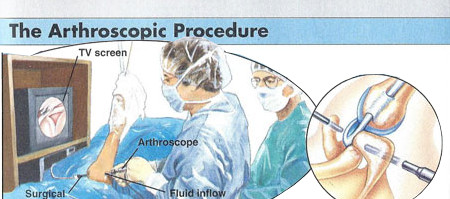Arthroscopy is usually a same day (outpatient) surgery.This means no overnight hospital stay is needed. You may have lab tests before the day of surgery. You’ll be asked not to eat or drink anything after midnight the night before your surgery.You are likely to have general and regional anesthesia.This medicine keeps you from feeling pain during the1- to 2-hour procedure. Your doctor will use the arthroscope to view your shoulder joint.He or she may also treat the joint using small instruments. The tiny incisions will then be stitched or taped, and your shoulder will be bandaged.

Understanding Shoulder Impingement
Impingement occurs when the subacromial space is too small to let the parts move easily. This may be caused by joint inflammation (swelling). Swollen parts of the shoulder take up more room,making the joint space smaller. The shape and condition of shoulder bones may also add to impingement.
How Problems Begin
Shoulder problems develop slowly over time. You may not notice a problem until it causes pain. There are many factors that can affect the shoulder.
Overuse
Constant shoulder use can irritate the tendons and bursa. Then the body sends more blood to the irritated areas, causing swelling.As the swelling gets worse,two problems can develop:
- Bursitis is inflammation of the bursa. The bursa fills up with too much fluid, filling and squeezing the joint space.
- Tendinitisis inflammation of the tendons. Swollen tendons make the joint space smaller.
Acromion Shape and condition: The acromion is part ofthe shoulder bone.It may be flat or hooked. If your acromion is hooked, the acromial space may be smaller than normal. This makes you more prone to shoulder problems. Bone spurs (growths on the bone) can also narrow the subacromial space.
Other causes: Your shoulder health may also be affected by poor posture, weak muscles, and other conditions.
Finding Relief: If shoulder problems remain untreated,They can lead to more serious problems. Read on to learn how to start treating your shoulder so it can heal.

